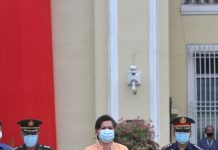by Antonio M. Ajero
MOST road accidents in Davao City happen along J.P. Laurel Avenue in what is called as central business district (CBD) by city planners and developers.
Accident monitoring
This was the finding of the Traffic Management Center based on traffic enforcers’ reports on accidents that occurred in the month of July, 2011, following the establishment by the TMC of a daily traffic accident monitoring system on the initiative of city councilor Pilar C. Braga, chair of the Davao City Council committee on transportation and communications.
Braga also provided the statistical tools in the monitoring system.
The accident statistics and analysis were contained in a seven-page report of Prof. Dario G. Pampanga, a licensed environmental planner who holds a master of arts degree in urban and rural planning. Braga provided Edge Davao with a copy of the report.
The daily monitoring, which is limited to where TMC enforcers are assigned, recorded a total of 462 road accidents in July. Of these, Braga said 204 mishaps or 44.16 percent occurred in the central business district, 152 or 32.90 percent in District 1, 62 or 13.42 percent in District 2, and 44 or 9.52 percent in District 3.
Accidents by streets
Of the bulk of accidents recorded, 23.5 percent occurred along J.P. Laurel Avenue, 7.3 percent along Quimpo Blvd., 6.4 percent along F. Torres St., Sta. Ana Ave. with 5.4 percent and Quirino Ave. and San Pedro St. with 4 percent each.
The CBD is used by all kinds of urban land transport vehicles like taxis, public utility buses (PUBs), public utility jeeps (PUJs), private vehicles and the pesky habal-habal and payong-payong motorcycles.
The CBD is where the vehicles congregate because it is where government offices, private offices, commercial and trading establishments, public markets, churches and other establishments are located, the report said.
“The CBD also has the highest concentration of pedestrians and sidewalk vendors, and the CBD serves as a huge convenient parking lot for almost all vehicles,” it said.
Private cars No. 1
The July monitoring also revealed that of the 462 accidents, 258 or more than 50 percent, involved private cars, 110 involved motorcycles, 90 involved taxis, 89 PUJs and 43 trucks.
Most accidents, 91.99 percent, were vehicle to vehicle. The rest vehicle to pedestrian, vehicle to property an self-inflicted (no second party involved).
Time of accidents
Prof. Pampanga said most road accidents, 46 percent, happened from 12 noon to 6 p.m., 39 percent during mornings from 6 a.m. to 12 noon, 13 percent during nighttime from 6 p.m. to midnight, and only 2 percent from midnight to 6 a.m.
“The introduction of daily accident monitoring report provided the city government an important resource that enhances the operation of traffic management in Davao City,” Pampanga said.
He said the constant monitoring of road and traffic accidents offers an actual grasp of ground situation on how motorists conduct themselves on the road, the apparent need for additional traffic enforcers, and the need for an expansive institutional mechanism that would provide attention to traffic management operations.
Recommendations
Finally, Prof. Pampanga gave the following recommendations:
• Immediate
– Institutionalize the daily road/traffic accident monitoring scheme and prompt monthly submission of the same to the office of Councilor Braga for study and analysis.
– Deploy city traffic enforcers to identified road/traffic accident prone areas
– Assign TOP-bearing traffic enforcers to accident prone areas
– Speed limit signs shall be erected and be implemented with dispatch along national roads and highways
– Conduct re-orientation of drivers, especially of private vehicles on traffic laws, rules and regulations, and city traffic ordinances.
• Short term
– Institute an implementing mechanism that would oversee the entire traffic and transport system in Davao City
– Provide necessary traffic-related instruments such as speed guns/cameras
– Continuing re-orientation of drivers, especially of private vehicles on traffic laws, rules and regulations, and city traffic ordinances
– Develop computer software to facilitate local transport/traffic data banking and retrieval system. This would primarily enable the city government to enhance the implementation and enforcement of various traffic laws, rules and regulations.






